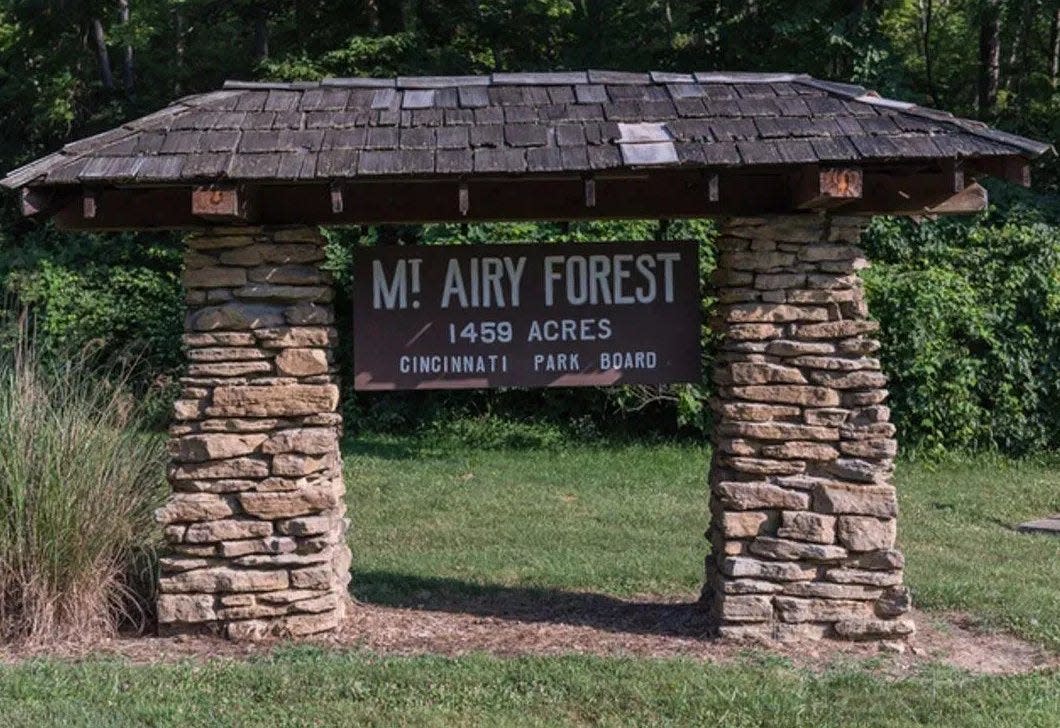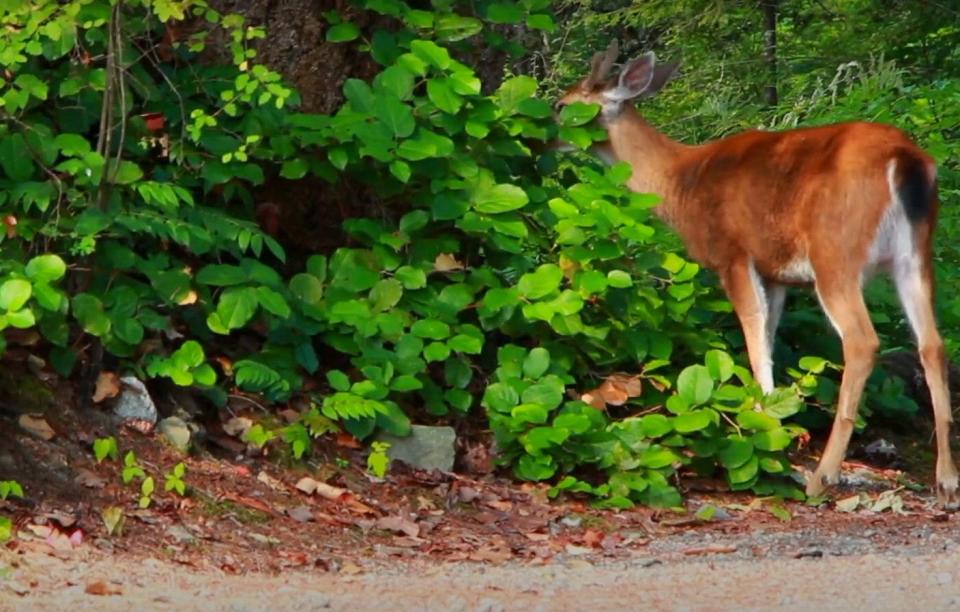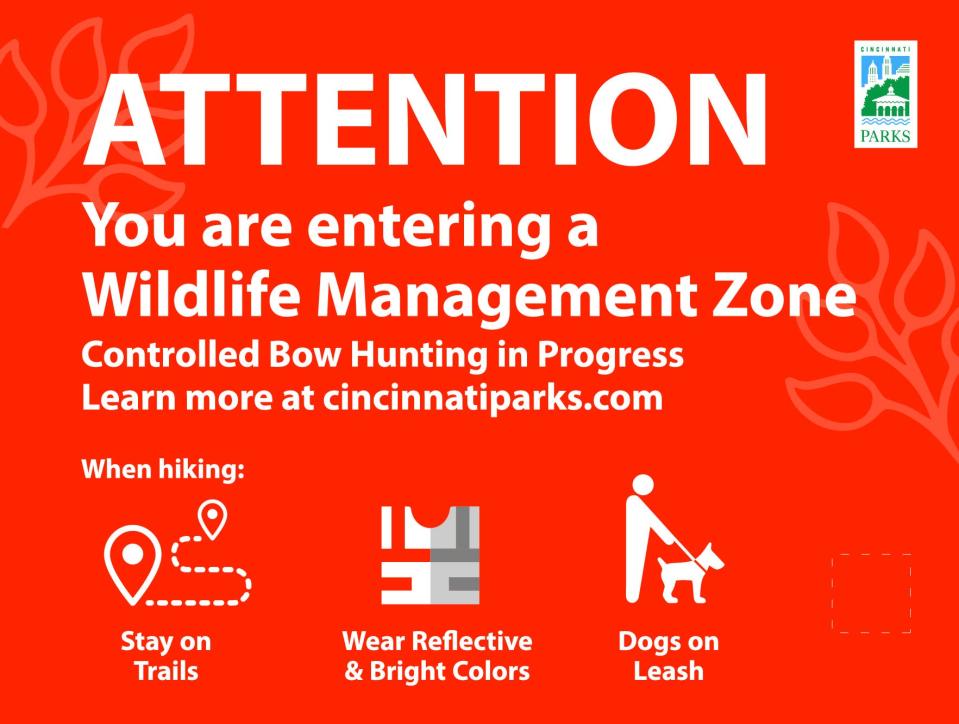Family 'horrified' by Ault Park deer hunt. This is why Cincinnati Parks allowed it

A couple and their 2-year-old daughter visiting Ault Park got an unwelcome surprise while walking a trail last weekend: Two hunters dragging out a deer they’d killed with bow and arrow.
“We were horrified,” the woman in the family wrote on Facebook, saying she and her husband alerted other parkgoers about the hunters as they fled the park.
The hunters, for their part, told her husband that controlled bow hunting is allowed in certain Cincinnati Parks locations to thin the deer population.
They were right.
In fact, the city park system has allowed bow hunting in some parks since 2007 to remove white-tailed deer who harm park ecosystems.
“Without the presence of (deer) predators, like mountain lions, wolves and black bears,” a September posting on the parks’ website says, “the uncontrolled overpopulation of deer threatens the natural environment.”
Where and when is bow hunting allowed?
Cincinnati Parks kicked off its current controlled bow hunting season Sept. 30 in 12 of its 109 sites. They are:
Alms Park, covering 94 acres in Mount Lookout.
Ault Park, a 224-acre site in Mount Lookout.
Caldwell Preserve, with 89 acres in Carthage.
California Woods Preserve, with 113 acres in California.
Daniel Drake Park, covering 66 acres in Kennedy Heights.
Glenway Woods, with 30 acres in Price Hill.
LaBoiteaux Woods, with 57 1/2 acres in College Hill.
Margrish Riverland Preserve, with 46 acres in California.
Miles Edward Park, a 37-acre site between Delhi and West Price Hill.
Seymour Nature Preserve, an 81-acre property in Carthage.
Stanberry Park, a 125-plus-acre facility in Mount Washington.
Seven areas of Mount Airy Forest: Bradford/Feter/Tanglewood Preserve, Bracken Woods, Maple Ridge, McFarlan Woods, Diehl Road, west and south of Arboretum to Shephard Creek Drive and a central-south parcel called Zone G, bordered by West Fork Road. Mount Airy, with 1,459 acres, is the largest city of Cincinnati park.
The participating parks have hunting zones, with maps on the parks' website.
The season ends Feb. 4.
How do deer hurt parks?
The Cincinnati Parks Division of Natural Resources launched the bow hunting program in 2007.
Since then, hunters have removed more than 2,000 deer from participating parks, parks spokesman Rocky Merz said.
Of those, hunters donated enough deer to Farmers and Hunters Feeding the Hungry to make 10,000 meals, Merz noted.
White-tailed deer are the targets. They are considered “browsers” who eat seedlings, leaves, buds, flowers, fruit, young trees and branches.
“Deer come in because they love the acorns,” parks administrator Crystal Courtney said in a video about the bow hunting program, posted to YouTube in 2020.
When they finish the acorns, they continue to eat away at 1-, 2-, 3- and 4-year-old trees, and other growth on the forest floor, said Courtney, division manager of natural resources. "All we had at the beginning of this program was just big, large trees,” she said.
With about 70% of the parks’ 4,400 acres covered in forests, the bow hunting program allows parks to “take the forest back” from browsers, she said.

Who gets to hunt?
Hunters must be registered and trained, and can shoot up to one buck and nine other deer in a season.
“They have to show that they are skilled archer men and women,” Courtney said in the video.
Hunters must demonstrate their skill by hitting targets. They must also complete training focused on safety and hunting regulations.
Bow hunters have not injured any park visitors over the life of the program, Merz said. "Our program serves as a model for other municipalities and organizations within the state," he said.
Registrations are closed for the current season and will reopen in late spring 2024.

How do parks address safety?
The borders of hunting zones in participating parks are at least 30 feet (or 10 yards) from park trails and at least 30 yards from neighboring properties, roads or buildings.
Parks that allow bow hunting post bright orange signs that say “Wildlife Management Zone.”
Hikers can take these steps to stay safe, according to the parks' website:
Learn where bow hunting is allowed from maps on the site.
Wear bright colors, especially at sunrise or sunset when the light is dimming.
Stay on marked trails.
Leash dogs and keep them on trails.
Until 2020, administrators closed some parts of participating parks during bow-hunting season. Responding to complaints, it created the 30-foot buffer plan to keep parks fully open.
Who else allows bow hunting of deer?
Cincinnati Parks is not the only park system with a bow hunting program.
Great Parks of Hamilton County allows bow hunting of deer in 16 of its 22 parks. Applications for its program, first launched in 2005, closed in July.
Ohio State Parks allow hunters to use bows and guns to hunt deer, wild turkey, coyote, feral swine, waterfowl and other species in many of its 75 locations.
The National Park Service allows some form of hunting in 76 of its 425 properties. OnX, maker of navigation apps for outdoor adventures, offers a how-to page with rankings of best sites by species.
What happened to the family at Ault Park?
The family that posted to the private Oakley/Hyde Park Cincinnati Moms and Friends Facebook page said the hunters they encountered last Sunday told them, “We know the difference between a deer and a human.”
“But still,” the poster said to that, “the thought of this occurring while on a walk with our family so close by is very unsettling.”
The writer said her husband contacted the Park Board about their concerns. The post generated about 50 comments, many registering surprise that hunting is allowed.
The writer did not respond to two messages seeking comment. Messages to two site administrators were also not returned.
The writer said she wanted to warn others about hunting in parks.
“If you plan to go walk some trails,” she wrote, “be aware, wear some crazy bright colors and make lots of noise.”
This article originally appeared on Cincinnati Enquirer: What Cincinnati parks allow deer hunting

